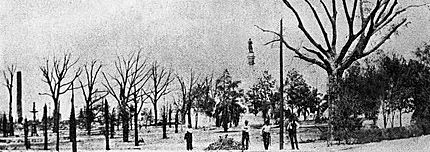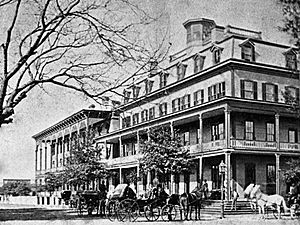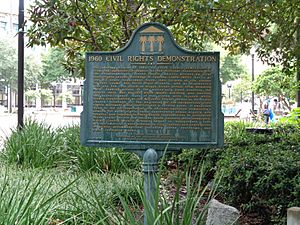James Weldon Johnson Park facts for kids
Quick facts for kids James Weldon Johnson Park |
|
|---|---|

James Weldon Johnson Park
|
|
| Type | Municipal |
| Location | Jacksonville, Florida |
| Area | 1.54 acres (6,200 m2) |
| Created | 1857 |
| Operated by | City of Jacksonville |
| Visitors | 1 million |
| Status | Open all year |
James Weldon Johnson Park is a 1.54-acre (6,200 m2) public park located in Downtown Jacksonville, Florida. It was the very first park in the city and is still the oldest one today. This park started as a simple village green, a common area for everyone to enjoy.
Contents
Park's Story: From Past to Present
How the Park Began
The land for the park was set aside in 1857 by Isaiah Hart, who founded Jacksonville. After he passed away in 1861, his family sold the land to the city for just $10.
At first, the park was called "City Park." Then, in 1869, a big hotel called the St. James Hotel was built across the street. So, the park's name changed to "St. James Park." Another large hotel was built nearby the next year.
The Hemming Monument and Name Change
In 1899, the park was renamed Hemming Park. This was to honor Charles C. Hemming, a veteran of the Civil War. He had paid for a 62-foot (19 m)-tall Confederate monument to be placed in the park in 1898. This monument was the oldest and tallest in the city at that time.
Charles Hemming was born in Jacksonville but later became a successful banker in Colorado. He wanted to build a memorial for Florida's Confederate soldiers. He chose the center of St. James Park for the monument, even though a popular fountain was there. The city agreed to move the fountain.
The monument was designed by George H. Mitchell from Chicago and cost about $20,000. It was a gift from Charles Hemming and his wife, Lucy Key Hemming. The monument was installed in 1898. The unveiling ceremony happened on June 16, 1898. Important people, including the nephew of Confederate General Robert E. Lee, attended the event.
The monument is sixty-two feet tall. It has a column made of Vermont granite, topped with a bronze statue of a Confederate soldier. The soldier wears a winter uniform and holds his rifle. The monument also has bronze plaques with images of Southern heroes. One plaque has an inscription likely written by Charles Hemming, honoring the soldiers.
To thank Charles Hemming for his gift, the City Council officially changed the park's name to Hemming Park on October 26, 1899.

In 1901, a huge fire, known as the Great Fire of 1901, destroyed most of Jacksonville. Hemming's Confederate monument was one of the few things that survived the fire. The St. James Hotel burned down, but a new building, also called the St. James Building, was built in its place in 1910.
Famous Visitors in the 1960s
Hemming Park became a place where important leaders gave speeches. In 1960, both John F. Kennedy and Richard Nixon, who were running for president, spoke at the park on the same day. Later, President Lyndon B. Johnson also gave a speech there in 1964.

Civil Rights Protests
During the 1960s, Hemming Park was a key location for civil rights demonstrations. Many African-American citizens protested to end racial segregation in public places. At that time, about 45% of Jacksonville's population was black.
Rutledge Pearson, a local teacher, and the NAACP organized students to take part in "sit-ins." These protests began on August 13, 1960. Students would go to segregated lunch counters at stores like Woolworths and ask to be served. They were often refused service and treated badly.
This continued until August 27, 1960, a day remembered as Ax Handle Saturday. On that day, a group of white men, some from the Ku Klux Klan, attacked the student protesters with axe handles and baseball bats. Some students found safety in the Snyder Memorial Church. Other black youths, known as the "Boomerangs," stepped in to protect the demonstrators.
The police did not get involved until the black groups started fighting back. Fifty people were hurt, and 62 were arrested. News of these events was shown on national TV and in major newspapers. Even after this violence, the sit-ins continued. Finally, after the Civil Rights Act of 1964, public facilities in the city became integrated.
Changes and Rebuilding
In the mid-1970s, the park's look changed. Many shade trees were removed because thousands of starlings were gathering there. In 1977, the city spent $648,000 to renovate the park, turning it into a concrete and brick-paved square. Its name was changed to Hemming Plaza.
Over the years, the city invested in rebuilding the area around the park. New buildings were constructed or renovated, including the John Milton Bryan Simpson United States Courthouse, the City Hall, a new Downtown Library, and the Jacksonville Museum of Contemporary Art.

In 2004, a bronze statue of U.S. Representative Charles Edward Bennett, who served Florida in Congress for 44 years, was placed in the park.
Recent Years
In 2014, a non-profit group called Friends of Hemming Park began managing the park. Their goal is to make the park lively and organize events there. Every first Wednesday of the month, the park becomes the center of Jacksonville's Downtown Art Walk.
On June 9, 2020, the park's Confederate monument was taken down. This happened during local George Floyd protests and after a three-year campaign to remove Confederate monuments.
On August 11, 2020, the Jacksonville City Council voted to change the park's name to James Weldon Johnson Park. This was to honor one of Jacksonville's most famous and talented residents, James Weldon Johnson.




